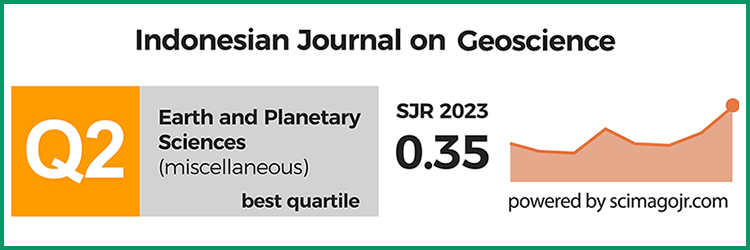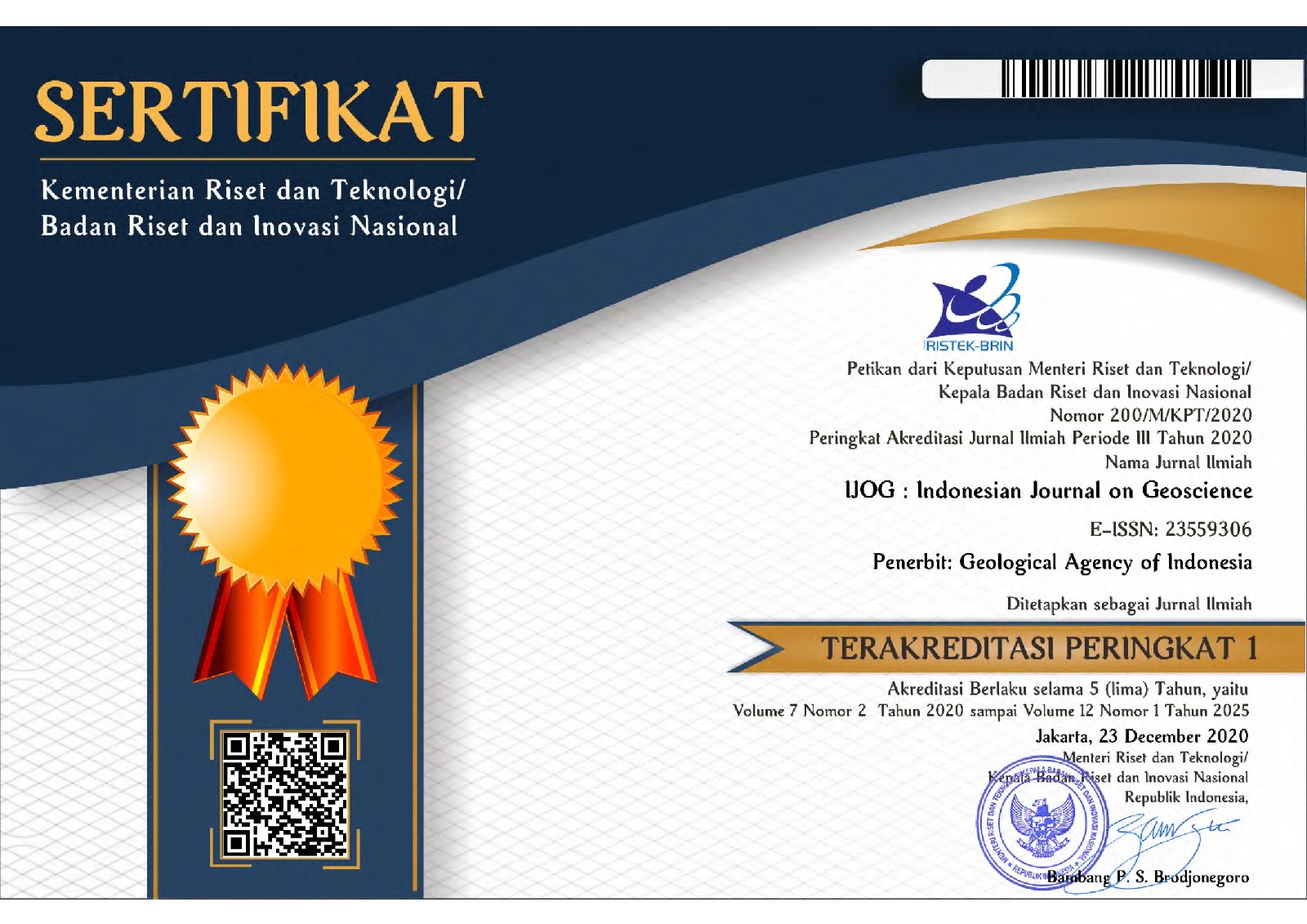Evaluasi awal kerentanan pelulukan/likuefaksi daerah Kendal dan sekitarnya, Jawa Tengah
DOI:
https://doi.org/10.17014/ijog.2.3.159-176Keywords:
liquefaction susceptibility, earthquake source, Kendal, faultAbstract
https://dx.doi.org/10.17014/ijog.vol2no3.20074
The investigated area is a region prone to liquefaction hazards since it consists of loose, saturated Quaternary deposits. The Quaternary deposits were deposited in several sediment environments such as swamp, estuary, near shore, off shore, and fluvial (flood plain, flood basin and paleo channel). Among those Quaternary deposits, the paleo channel and estuary deposits which mainly consist of fine - to medium - sand have high susceptibility to liquefaction.
An earthquake-source zone which is able to trigger earthquake and to cause liquefaction hazards is known to be thrust fault and subduction zones. Earthquakes produced by thrust fault activities are classified as shallow earthquakes while earthquakes produced by a subduction zone are deep earthquakes.
The investigated area is divided into low liquefaction susceptibility, moderate susceptibility and high liquefaction susceptibility zones. This division has been made based on physical characteristic of the sand deposits, grain size, thickness of sand and its position to groundwater level as well as the physical character of overburden layer.
References
Folk, L.R., 1961. Petrology of Sedimentary Rocks. The University of Texas.
Lumbanbatu U.M., dan Soemantri P., 2007. Dinamika Geologi Kuarter Dataran Pantai Daerah Kendal Provinsi Jawa Tengah. Dalam persiapan terbit di Jurnal Pusat Pengembangan Geologi Kelautan. Bandung.
Lumbanbatu U.M., 2004. Kajian Potensi bencana Pelulukan (Liquefaction) di Daerah Semarang dan Sekitarnya. Jurnal Sumber Daya Geologi, 1 (1), Pusat Survei Geologi.
Matti J.C., 1991. Liquefaction Susceptibility in the San Bernardino Valley and Vinicity, South California; A Regional Evaluation. U.S. Geological Bulletin 1898.
Obermeier S.F., Martin J.R., Frankel A.D., Yould T.L., Munson P.J., Munson C.A., dan Pond, E.C., 1993. Liquefaction Evidence for One or More Strong Holocene Earthquakes in the Wabash of Southern Indiana and Illinois, with a Preliminary Estimate of Magnitude. U.S. Geological Survey Professional Paper 1536. United State Government Printing Office, Whasington
Reading, H.G,. 1978. Sedimentary Environments and Facies. Blackwell Scientific Publications, Oxford, London, Edinburgh, Boston, Palo Alto, Melbourne.
Reineck, H.E. dan Singh, I.B., 1973. Depositional Sedimentary Environment. Springer-Verlag Berlin Heidelberg New York.
Seed, H.B., dan Idriss, I.M., 1971. Simplified procedure for evaluating soil liquefaction potential. Proceeding of the American Society of Civil Engineering, Journal of the Soil Mechanics and Foundations Division, 97 (SM).
Seed, H.B., Idriss, I.M., and Arango, I., 1983. Evaluation of liquefaction potential using field performance data. Journal of the Geothechnical Engineering Division, 109 (3), p. 458-482
Thanden, R.E., Sumadirdja, H., Richards, P.W., Sutisna, K., dan Amin, T.C., 1996. Peta Geologi Lembar Magelang dan Semarang, Skala 1 : 100.000. Pusat Survei Geologi Bandung.
Tinsley, J.C., Yould T.L., Perkin, D.M., dan Chen, A.T.F., 1995. Evaluating Liquefaction Potensial. U.S Geological Survey Professional Paper 1360. United State Government Printing Office, Washington.
Yould, T.L., dan Perkin D.M., 1978. Mapping liquefaction- induced ground failure potential. Journal of the Geotechnical Engineering Division, ASCE., 104, GT4.
Wang, 1979. https://www.ce.washington.edu/~liquefaction/html/susceptible2,
html: Which soils are liquefaction susceptible?



















